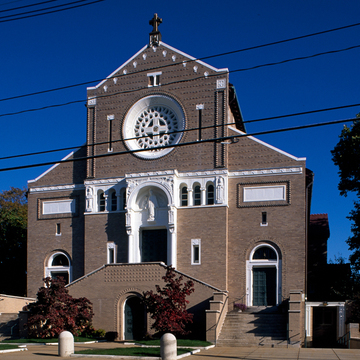St. Catherine of Genoa is a seminal building in the development of early-twentieth-century American Roman Catholic church architecture. With its sand gray brick and glazed terra-cotta exterior, St. Catherine became a paradigm for the propagation of the Italian Lombardian style. Charles D. Maginnis advocated this style for its association with Early Christian architecture and for the design possibilities and economy of using brick rather than more costly stone. Based on Byzantine precedents, the lavish eclectic interior contains premier examples of liturgical arts—stucco and terra-cotta modeling by Hugh Cairns, woodwork by Irving and Casson, Stations of the Cross by Angelo Lualdi, sanctuary paintings by Alexander Locke, and pulpit and pictorial panels carved in low relief by Johannes Kirchmayer. The supreme artistry reflects the architect's leadership role as founding member of the Catholic Federation of Arts; the Liturgical Arts Society; and the Society of Arts and Crafts, Boston.
You are here
St. Catherine of Genoa Church
If SAH Archipedia has been useful to you, please consider supporting it.
SAH Archipedia tells the story of the United States through its buildings, landscapes, and cities. This freely available resource empowers the public with authoritative knowledge that deepens their understanding and appreciation of the built environment. But the Society of Architectural Historians, which created SAH Archipedia with University of Virginia Press, needs your support to maintain the high-caliber research, writing, photography, cartography, editing, design, and programming that make SAH Archipedia a trusted online resource available to all who value the history of place, heritage tourism, and learning.









